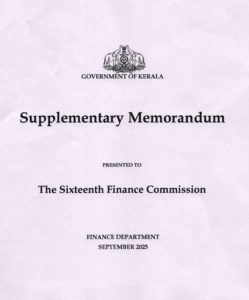Kerala highlighted its vulnerability to GST changes, noting that its consumption basket is heavily skewed toward items that attract higher taxes.
Published Sep 20, 2025 | 9:00 AM ⚊ Updated Sep 26, 2025 | 11:46 AM

GST revenue of Kerala expected to drop following the reforms. (iStock)
Synopsis: The Next-Gen GST reforms — effective on 22 September — are being seen in Kerala less as a festive bonanza and more as a looming fiscal burden. The state’s Finance Department has flagged that the reforms could have a disproportionately harsh impact on its revenues compared to other states.
Billed by the Prime Minister as a “Diwali gift for the common man,” the Next-Gen GST reforms — announced with much fanfare on 4 September and will become effective on 22 September — are being seen in Kerala less as a festive bonanza and more as a looming fiscal burden.
While the Union government celebrates the simplification of the tax regime into two neat slabs of five percent and 18 percent, the state fears the move could burn a hole in its coffers, with an estimated annual revenue loss of ₹8,000–₹9,000 crore.
For a state already vocal about the Union government’s policies draining its resources, the gift looks more like a loss, and it is being unwrapped with little cheer in Kerala.
The 56th meeting of the GST Council, chaired by Union Finance Minister Nirmala Sitharaman, approved the much-hyped Next-Gen GST reforms — projected as a major step towards improving ease of doing business and simplifying taxation.
Prime Minister Narendra Modi hailed the reforms as a move that would directly benefit the common man, farmers, Micro, Small & Medium Enterprises (MSMEs), women, youth, and middle-class families, while setting the foundation for India’s long-term economic growth.
However, for Kerala, the “gift” comes wrapped with a warning label.
The state’s Finance Department has flagged that the reforms could have a disproportionately harsh impact on its revenues compared to other states.
The state Finance Department points out that Kerala, being a consumer state, earns a major share of its GST revenues from goods and services taxed at the higher 28 percent and 18 percent slabs.
With the restructuring, the four existing GST slabs of five percent, 12 percent, 18 percent and 28 percent have been reduced to just two — five percent and 18 percent. There is also a new 40 percent slab that has been imposed on luxury and sin goods.
Studies, including those by the Thiruvananthapuram-based Gulati Institute of Finance and Taxation (GIFT), an autonomous institute under the state Finance Department, show that this rejig could hit Kerala especially hard.
GIFT’s analysis reveals:
By shifting the 12 percent slab down to five percent, Kerala is staring at a 58 percent fall in tax revenue from those product categories.
Similarly, moving goods like ACs, washing machines, cement, motor vehicles, tyres, and refrigerators from the 28 percent slab to 18 percen is expected to slash the state’s income further.
Kerala estimates an annual revenue loss of ₹8,000–₹9,000 crore due to these reforms. GIFT, using e-way bill data from 2018-19 and 2019-20, further estimates that the state could lose ₹6,300 crore per year on a per-item basis.
Acknowledging this, the state in September approached the 16th Finance Commission with a supplementary memorandum.

The cover page of the supplementary memorandum
In a supplementary memorandum submitted alongside the deliberations, the state argued that the sweeping rate cuts — especially the shifting of nearly 30 goods from the 28 percent slab to 18 percent — will leave its finances battered, without delivering the promised consumer gains.
While acknowledging the need to ease the burden of high GST rates on households, Kerala raised fundamental questions: Will the reductions translate into lower prices for consumers? And even if they do, can they realistically stimulate enough additional demand to offset the revenue loss?
Kerala highlighted its vulnerability to GST changes, noting that its consumption basket is heavily skewed toward items that attract higher taxes.
With a per capita income of ₹2.63 lakh (8th in the country), the state’s relatively affluent population tends to spend more on goods in the higher slabs — making it disproportionately dependent on revenues from them.
The memorandum drew parallels with the November 2017 rationalisation, which saw rates cut for 178 items.
That move, Kerala noted, sent its compensation requirement spiralling from ₹2,102 crore in 2017-18 to ₹12,828 crore in 2020-21, before the end of the compensation regime.
“This time, with no provision for compensation, the damage will be even sharper,” the memorandum warned.
The Union government’s counter-argument is that cheaper goods will spur consumption, softening the blow.
However, Kerala rejected this optimism on two counts:
The state stressed that even if consumers benefit from marginal price cuts, the revenue base will not recover.
Kerala also contextualised the issue in its broader fiscal stress. Despite contributing around four percent of national Gross Domestic Product (GDP), its tax revenue-to-GSDP ratio has dropped from percent in 2015-16 to 2.62 percent in 2024-25.
Meanwhile, its share in the Union divisible pool has been steadily declining — from 3.9 percent under the 10th Finance Commission to just 1.925 percent under the 15th.
The GST system, Kerala argued, has fundamentally altered its earlier tax structure, designed to match high living standards, leaving it fiscally compressed even as development needs remain high.
To deal with what it calls a “structural imbalance” in GST’s impact, Kerala has urged the Sixteenth Finance Commission to consider:
The state has made it clear that, unlike other parts of the country, it cannot rely on boosted consumption to make up for lost revenues.
Unless corrective measures are built into the system, Kerala warns, the latest reforms will leave its already stressed exchequer even more precarious.
At the same time, Finance Minister KN Balagopal told the Assembly on 17 September that Kerala is bracing for a dip in its tax revenue after the GST Council approved the Union government’s reform proposal without addressing states’ demands for compensation on tax loss.
He said that while steps are being taken to strengthen the GSTN system and minimise revenue leakage, the state faces uncertainty as the bulk of its GST revenue comes from goods and services taxed at 28 percent and 18 percent.
Balagopal pointed out that factors like tax rate inversion and changes in market demand could significantly affect revenue, but the Union proposal lacks clarity on the scale of potential loss, leaving states like Kerala with no precise estimates to rely on.
However, he added that, to tackle the impact, the government is putting in place several corrective measures: Strengthening the GSTN system for closer monitoring of IGST settlements, tightening mechanisms to plug leakages, and streamlining compliance to make revenue flow more efficient.
The finance minister also stressed that Kerala would continue to push for a fair compensation mechanism while taking its own steps to safeguard the state’s fiscal stability.
In short, what the Centre hails as a “Diwali gift” has become a fiscal shock for Kerala. The state sees the GST rejig not as simplification but as a structural setback. The reforms may brighten Delhi’s narrative but dim the state’s fiscal future.
(Edited by Muhammed Fazil.)
